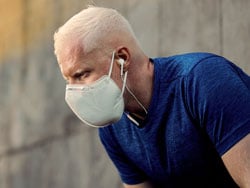During Bill Clinton's 1992 presidential campaign, one of his political advisers, James Carville, was convinced that Clinton would win the election if he focused on the economy. "It's the economy, stupid" was the phrase he used to emphasize its importance. Clinton won the election and the phrase became famous. I have found it apropos in the case of post-COVID exercise limitations: "It's deconditioning, stupid."

What is deconditioning? In lay terms, it's synonymous with being out of shape. In medical terms, it's the process by which human beings lose muscle mass and aerobic capacity following inactivity. The rate at which deconditioning occurs is dependent on a number of factors. Speaking from personal and professional experience, I promise you that it occurs quickly. One hallmark of deconditioning is poor self-awareness and the tendency to attribute symptoms to organ dysfunction rather than lack of fitness.
Much like a national campaign strategy, exercise physiology and COVID-19 infection are both complicated. We're starting to get data from cardiopulmonary exercise testing (CPET) post infection, though, and lo and behold, the predominant limitation found during testing is deconditioning. Post–COVID-19 CPET studies examined inpatients within 3 months of discharge. They found that aerobic capacity was more related to hospital length of stay, age, the need for mechanical ventilation, or ICU admission than it was to persistent deficits on lung function testing. One could then infer that loss in aerobic capacity is mediated by age and duration plus degree of immobility, all factors related to deconditioning. Really, this should surprise no one. The data showing early loss of muscle mass in healthy volunteers, critically ill patients, and those admitted for an acute exacerbation of COPD are quite robust.
Data on patients with post–pulmonary embolism (PE) syndrome provide an interesting comparison to what we're seeing post COVID-19. A well-done CPET study showed that deconditioning drives persistent symptoms out to a year post PE diagnosis. We label such patients as having post-PE syndrome. While some do have pulmonary hypertension or residual gas exchange abnormalities, they account for the minority. It's quite likely that we're going to see the same phenomenon with COVID-19 — lots of concern over residual effects from acute disease, but symptoms turn out to be due to inadequate time and effort put into rehabilitation.
Is deconditioning responsible for all post-COVID activity limitations? If only it were that simple. The title of this piece belies some important realities. The CPET studies cited were all conducted within 3 months of hospitalization. Some were done at 4 weeks post discharge, and one even exercised patients while they were still inpatients. This doesn't provide the time required for proper recovery, whether hospitalization is due to COVID-19, COPD, or PE. It's possible that patients initially struggling with conditioning will ultimately be limited by residual lung injury as their fitness improves. Many of the studies excluded patients with established comorbid cardiopulmonary disease, too, making the data less generalizable.
We also know little about what's causing post–COVID-19 activity limitations in those who weren't hospitalized for their acute infection. More than 90% of those infected in the United States are treated as outpatients, but only two of the studies I found enrolled participants who weren't hospitalized for their acute infection. One posited that a COVID-19–related myopathy led to limitations, and the other found high rates of dysfunctional breathing. Total sample size combined was only 18 patients. We need more research here.
In summary, if your patient was hospitalized for COVID-19, they're deconditioned. The degree and duration of deconditioning will vary by age, length of stay, iatrogenia (like steroids or paralysis), and fitness level prior to admission. Younger, healthier post–COVID-19 outpatients have not been well studied. Deconditioning is not the sole contributor to post–COVID-19 symptoms, but until we learn more about the complex interaction between recovery times and disease effects, it provides a target for treatment. "It's deconditioning, stupid."
Aaron B. Holley, MD, is an associate professor of medicine at Uniformed Services University and program director of pulmonary and critical care medicine at Walter Reed National Military Medical Center. He covers a wide range of topics in pulmonary, critical care, and sleep medicine.
Follow Medscape on Facebook, Twitter, Instagram, and YouTube
"stupid" - Google News
November 24, 2021 at 11:19PM
https://ift.tt/3DSLBgI
'It's Deconditioning, Stupid': Exercise Limitations After COVID-19 Infection - Medscape
"stupid" - Google News
https://ift.tt/3b2JB6q
https://ift.tt/3febf3M
Bagikan Berita Ini














0 Response to "'It's Deconditioning, Stupid': Exercise Limitations After COVID-19 Infection - Medscape"
Post a Comment